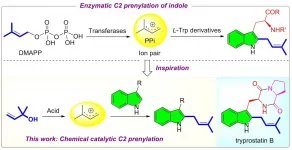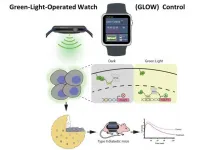Mechanisms of kidney protection by gliflozins
There is now evidence of how SGLT2 inhibitors slow the progression of chronic kidney disease, regardless of diabetes status
2021-06-07
(Press-News.org) SGLT2 inhibitors (gliflozins) were developed as oral antidiabetics. They enhance urinary glucose excretion by inhibiting SGLT-2 (sodium-dependent glucose co-transporter-2) in the renal tubuli. The discovery of kidney benefits beyond the lowering of blood sugar has been made by Professor Christoph Wanner from Germany: The EMPA-REG OUTCOME study [2] initially showed that the rate of cardiovascular events in type 2 diabetic pa-tients is significantly reduced if the SGLT2 inhibitor empagliflozin is administered. Kidney function in diabetics who already had diabetic nephropathy was also found to benefit sig-nificantly from the treatment (as an incidental finding, so to speak) [3]. In other cardio-vascular outcome studies, this effect has been confirmed for other SGLT2 inhibitors in type 2 diabetics with diabetic nephropathy (albuminuria) [4, 5, 6]. The DAPA-CKD study [7, 8] showed that, even in non-diabetic CKD patients, i.e., in patients with other under-lying causes of kidney disease, the combined renal endpoint (loss of renal function ?50%, dialysis requirement or mortality) is significantly delayed by SGLT2 inhibition with dapagliflozin (HR 0.61).
The mechanisms by which SGLT2 inhibitors produce their renoprotective effect are still largely unknown. A post-hoc analysis using data from the EMPA-REG OUTCOME study looked for possible factors that could mediate or be correlated with this effect. The pooled treatment group (empagliflozin 10 and 25 mg/d) was compared with the placebo group. A total of 17 different potential factors from different physiological areas were reg-istered at the start of the study and statistically evaluated on a time-dependent basis (Cox regression with time-dependent covariates) and also at the time of week 12 (orien-tation point analysis). The variables were incrementally summed according to the strength of their effect on the composite renal endpoint.
In time-dependent analysis, the unadjusted EMPA effect on the renal endpoint was HR 0.56 (probability or risk reduction, i.e., treatment was 44% less likely to reach the renal endpoint).
In more advanced CKD stages, the kidneys no longer produce sufficient amounts of the blood-forming hormone erythropoietin, thus resulting in renal anemia (as indicated by lowered hematocrit levels). After adjusting the hematocrit (HK) value over time, the HR for the EMPA effect was 1.0; the HK value was therefore the strongest mediator. Other factors were serum uric acid concentration (33.2%) and albuminuria (31%). At week 12, the unadjusted HR for the treatment effect on the renal endpoint was 0.54. Once again, HK was the strongest mediator of the EMPA effect. After adjusting for the HK value, the HR was 0.69 - from which a mediation effect of 40.7% was calculated. Other factors were HbA1c (28.3%), blood pressure (16.8%) and fatty acid levels (16.5%). The compo-site effect of HK, HbA1c, blood pressure and fatty acid levels was 78.9%.
"We know that severe anemia is a predictor not only for CKD progression, but also for cardiovascular events," explains Prof. Dr. Christoph Wanner. "According to the new study data, hematocrit is the most important mediator of the positive gliflozin effects, i.e., the main mechanism by which the SGLT2 inhibitors stabilize renal function and improve the clinical outcome correlates with the percentage increase in erythrocytes. These correla-tions now need to be investigated further - for example, to determine whether a role is played here by hemoconcentration due to increased urinary excretion induced by gliflozin, or by enhanced erythrocyte production."
"With gliflozins, we have been experiencing the first real breakthrough in the treatment of chronic kidney disease in a long time, or since the establishment of the standard RAS blockade (with ACE inhibitors or angiotensin receptor blockers), the aim being to delay the need for dialysis treatment as long as possible."
INFORMATION:
[1] 2439 Wanner C... Mediators of the empagliflozin treatment effect on kidney outcomes in the EMPA-REG Outcome Trial.
[2] Zinman B, Wanner C, Lachin JM et al. Empagliflozin, cardiovascular outcomes, and mortality in type 2 diabetes. N Engl J Med 2015; 373: 2117-2128
[3] Wanner C, Inzucchi SE, Lachin JM et al. Empagliflozin and Progression of Kidney Disease in Type 2 Di-abetes. N Engl J Med 2016; 375: 323-334
[4] Neal B, Perkovic V, Mahaffey KW et al. Canagliflozin and cardiovascular and renal events in type 2 dia-betes. N Engl J Med 2017; 377: 644-657
[5] Wiviott SD, Raz I, Bonaca MP et al. Dapagliflozin and cardiovascular outcomes in type 2 diabetes. N Engl J Med 2019; 380: 347-357
[6] Perkovic V, Jardine MJ, Neal B et al. Canagliflozin and renal outcomes in type 2 diabetes and nephrop-athy. N Engl J Med 2019; 380: 2295-2306
[7] Heerspink HJL, Stefánsson BV, Correa-Rotter R et al. Dapagliflozin in Patients with Chronic Kidney Disease. N Engl J Med 2020; 383 (15): 1436-1446
[8] Wheeler DC, Stefánsson BV, Jongs N et al. Effects of dapagliflozin on major adverse kidney and cardi-ovascular events in patients with diabetic and non-diabetic chronic kidney disease: a prespecified analysis from the DAPA-CKD trial. Lancet Diabetes Endocrinol 2021; 9 (1): 22-31
About ERA-EDTA
With more than 7,000 active members, the ERA-EDTA is one of the biggest nephrology associations worldwide leading European nephrology and one of the most important European Medical Associations. It organizes annual congresses and other educational and scientific activities. ERA-EDTA also produces guidelines, collects data, and performs epide-miological studies through its Registry. The Society supports fellowships and educational/research projects through its committees and working groups. Its publications are NDT, CKJ (Open Access journal), and the online educational jour-nal NDT-Educational. The 2020 Congress will be held on 6-9 June in Milan, Italy.
Website: http://www.era-edta.org
ELSE PRESS RELEASES FROM THIS DATE:
2021-06-07
HOUSTON - (June 7, 2021) - If identical versions of 20 people lived out their lives in dozens of different worlds, would the same people be popular in each world?
If you substitute "fruit flies" for "people" in that question, you have a fair description of a Rice University study showing that the evolution of social structures and the positions of individuals within those structures are based partly on genetics.
Cloned fruit flies played a starring role in the study that researchers jokingly likened to "The Truman Show," with video cameras observing how the flies behaved in a controlled environment.
In the study published online this week in Nature Communications, Rice bioscientists Eric Wice and Julia Saltz ...
2021-06-07
The kidneys are a target organ of COVID-19 and are affected very early in the course. However, this is precisely where there is strong prognostic potential: As early as last spring, COVID-19-associated nephritis was identified as an early warning signal for severe courses of the infectious disease and studies to that effect were published [1]. In that regard, the research group led by Professor Oliver Gross, Department of Nephrology and Rheumatology at Göttingen University Medical Center (UMG), screened 223 patients in a study and included 145 of them as a predictive cohort. Study endpoints were ICU admission or mortality. As a result, early urinary changes ...
2021-06-07
It was clear at a relatively early stage of the pandemic that SARS-CoV-2 causes a wide range of symptoms; in addition to typical respiratory symptoms, patients also had neurological symptoms (starting with anosmia), gastrointestinal symptoms, elevated liver values, and renal, urinary or hematological changes, for example. The fact that such findings occurred not only in severely ill patients with general organ dysfunction suggested that the virus may potentially cause disorders in various organs directly, i.e. that it causes a multi-system disease.
In spring 2020, at the very beginning of the pandemic, the authorities in Hamburg ordered autopsies be performed on all patients who had died with COVID-19. This resulted in one of the ...
2021-06-07
Various viruses and bacteria have long been known to cause autoimmune diseases where there is such a predisposition. This phenomenon also seems to play a major role in SARS-CoV-2, especially in severe courses. The body's own immune cells are activated, with the formation of autoantibodies that attack the body's own healthy cell structures (proteins, autoantigens); deposits of immune complexes can then trigger severe inflammatory processes and cell destruction in the body.
Some nephrological diseases are likewise of autoimmunological etiology, one example being systemic lupus erythematosus (SLE), a chronic, mostly relapsing-remitting inflammatory disease with life-threatening ...
2021-06-07
Terpenoids are omnipresent in almost all living organisms. Prenylated indoles are prominent representatives that usually display potent medicinal properties (e.g. tryprostatin B). Therefore, significant efforts have been devoted to indole prenylation over the past decades. The known protocols often require a multi-step procedure and rely on the use of stoichiometric promoters. From the viewpoint of step- and atom-economy, developing a direct catalytic C2 prenylation of indoles is highly desirable yet challenging, because the nucleophilicity of C2 site is weaker than that of other two positions ...
2021-06-07
Consuming large amounts of daily caffeine may increase the risk of glaucoma more than three-fold for those with a genetic predisposition to higher eye pressure according to an international, multi-center study. The research led by the Icahn School of Medicine at Mount Sinai is the first to demonstrate a dietary - genetic interaction in glaucoma. The study results published in the June print issue of Ophthalmology may suggest patients with a strong family history of glaucoma should cut down on caffeine intake.
The study is important because glaucoma is the leading cause of blindness in the United States. It looks at the impact of caffeine intake on glaucoma, ...
2021-06-07
Research Highlights:
Rates of Kawasaki disease - a condition that creates inflammation in blood vessels in the heart and is more common in children of Asian/Pacific Island descent - have substantially decreased in South Korea during the COVID-19 pandemic.
The decrease could be due to mask-wearing, hand-washing, school closures and physical distancing, suggesting Kawasaki disease may be prompted by infectious agents.
The cause of Kawasaki disease is unknown, though it may be an immune response to acute infectious illness.
DALLAS, June 7, 2021 -- The rate of Kawasaki disease in South Korea has substantially decreased during the COVID-19 pandemic, possibly due to pandemic prevention efforts, such as mask-wearing, ...
2021-06-07
CAMBRIDGE, MA -- MIT engineers have discovered a new way of generating electricity using tiny carbon particles that can create a current simply by interacting with liquid surrounding them.
The liquid, an organic solvent, draws electrons out of the particles, generating a current that could be used to drive chemical reactions or to power micro- or nanoscale robots, the researchers say.
"This mechanism is new, and this way of generating energy is completely new," says Michael Strano, the Carbon P. Dubbs Professor of Chemical Engineering at MIT. "This technology is intriguing because all you have to do is flow a solvent through a bed of these particles. ...
2021-06-07
Many modern fitness trackers and smartwatches feature integrated LEDs. The green light emitted, whether continuous or pulsed, penetrates the skin and can be used to measure the wearer's heart rate during physical activity or while at rest.
These watches have become extremely popular. A team of ETH researchers now wants to capitalise on that popularity by using the LEDs to control genes and change the behaviour of cells through the skin. The team is led by Martin Fussenegger from the Department of Biosystems Science and Engineering in Basel. He explains the challenge to this undertaking: "No naturally occurring molecular ...
2021-06-07
Levels of a protein called neurofilament light chain (NfL) in the blood can identify those who might have neurodegenerative diseases such as Down's syndrome dementia, motor neuron disease (ALS) and frontotemporal dementia, when clinical symptoms are not definitive.
Published in Nature Communications and part-funded by the NIHR Maudsley Biomedical Research Centre, the research determined a set of age-related cut-off levels of NfL which could inform its potential use in primary care settings through a simple blood test.
Joint Senior Author on the study, Dr Abdul Hye from the NIHR Maudsley Biomedical Research Centre at King's College London and South London and Maudsley NHS Foundation Trust said: 'For the first time we have shown ...
LAST 30 PRESS RELEASES:
[Press-News.org] Mechanisms of kidney protection by gliflozins
There is now evidence of how SGLT2 inhibitors slow the progression of chronic kidney disease, regardless of diabetes status


